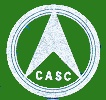





General Manager Mr. Liheng Wang Address: 9 Fucheng Rd., Haidian District, Beijing Telephone: 68370043, 68370699 Fax:68370080 P.O. Box 949, Beijing Zip code: 100830 Web address: www.spacechina.com
 The China Aerospace Science and Technology Corporation (CASC) evolved from the former China Aerospace Corporation encompassing some of its organizations. With the approval of the State Council, on 01 July 1999, in an effort to become more competitive the Chinese government reformed the top ten Defense and Technology Corporations. These corporations, including the former China Aerospace Corporation, are all large State Owned Enterprises(SOE's) under direct supervision of the State Council. The former China Aerospace Corporation, with some 270,000 employees, was divided into the China Aerospace Science and Technology Corporation (CASC) and the China Aerospace Machinery and Electronics Corporation (CAMEC), presumably with about 150,000 employees. The S&T Corporation has adopted CALT, the Fourth Academy, CAST, 062 Base, and 067 Base. The Electro-mechanical Corporation has integrated the Second and Third Academies and the remaining bases. A large state-owned enterprise, CASC constitutes the Government-authorized investment organization under the direct supervision of the State Council, with a registered capital of RMB 9 billion yuan.
Over 130 organizations are subordinate to CASC, including five large research academies, i.e., Chinese Academy of Launch Vehicle Technology (CALT), Chinese Academy of Space Technology (CAST), Shanghai Academy of Space Flight Technology (SAST), Chinese Academy of Space Electronic Technology (CASET), and the Academy of Space Chemical Propulsion Technology, two large research and manufacture bases [Sichuan Space Industry Corporation and Xian Space Science & Technology Industry Corporation], as well as a number of factories, research institutes under the direct supervision of the headquarters, and companies in which CASC has major or minor shares. CASC employs around 110,000 employees, in which technical staff accounts for more than 40,000, including over 1,300 researchers and 21 academicians of both Chinese Academy of Sciences and Chinese Academy of Engineering.
The China Aerospace Science and Technology Corporation (CASC) evolved from the former China Aerospace Corporation encompassing some of its organizations. With the approval of the State Council, on 01 July 1999, in an effort to become more competitive the Chinese government reformed the top ten Defense and Technology Corporations. These corporations, including the former China Aerospace Corporation, are all large State Owned Enterprises(SOE's) under direct supervision of the State Council. The former China Aerospace Corporation, with some 270,000 employees, was divided into the China Aerospace Science and Technology Corporation (CASC) and the China Aerospace Machinery and Electronics Corporation (CAMEC), presumably with about 150,000 employees. The S&T Corporation has adopted CALT, the Fourth Academy, CAST, 062 Base, and 067 Base. The Electro-mechanical Corporation has integrated the Second and Third Academies and the remaining bases. A large state-owned enterprise, CASC constitutes the Government-authorized investment organization under the direct supervision of the State Council, with a registered capital of RMB 9 billion yuan.
Over 130 organizations are subordinate to CASC, including five large research academies, i.e., Chinese Academy of Launch Vehicle Technology (CALT), Chinese Academy of Space Technology (CAST), Shanghai Academy of Space Flight Technology (SAST), Chinese Academy of Space Electronic Technology (CASET), and the Academy of Space Chemical Propulsion Technology, two large research and manufacture bases [Sichuan Space Industry Corporation and Xian Space Science & Technology Industry Corporation], as well as a number of factories, research institutes under the direct supervision of the headquarters, and companies in which CASC has major or minor shares. CASC employs around 110,000 employees, in which technical staff accounts for more than 40,000, including over 1,300 researchers and 21 academicians of both Chinese Academy of Sciences and Chinese Academy of Engineering.
CASC has the ability to develop and launch low earth orbit (LEO), geostationary, and sun-synchronous rockets. It ranks among the world's most advanced in such areas as high energy propellant technology, strap-on boosters, and launching multiple satellites atop a single rocket. The company can also develop such spacecraft as communication satellites, meteorological satellites, earth resource satellites and scientific experimental satellites, with leading technologies in satellite recovery, orbit control and attitude control. In addition, CASC is strong in satellite applications, information technology, automatic control and system integration.
The China Aerospace Science and Technology Corporation specializes in developing, manufacturing and supplying spacecraft launch vehicles and various types of Strategic and tactical missiles. In addition, CASC exclusively provides international commercial launch service for satellite application systems. In addition to the above space products and services, CASC also develops, manufactures and supplies a variety of civilian products such as machinery, chemicals, communications equipment, transportation equipment, computers, medical care products and environmental protection equipment. At the same time, CASC is engaged in purchase bids, contracting over seas projects, technical consultation and labor export.
The former China Aerospace Corporation (CASC) was responsible for Chinese missile and space activities, including satellites, launch vehicles and ground support system. It was also engaged in a variety of civilian products such as automobiles and computer applications. CASC had 270,000 employees, of whom 30% are technicians, engineers and researchers, including some 40,000 professors and senior engineers.
The origins of CASC date to the October 1956 establishment of Military Academy 5, a specialized research organization for China's missiles and launch vehicles, which became Ministry 7 in 1964. This ministry was subsequently renamed the Ministry of Aerospace Industry [MOA]. A number of primary research academies (yanjiuyuan) focus on launch vehicles and ballistic missiles. A system of bases (jidi), numbered 061 through 068, located around the country have a wide range of manufacturing and R&D responsibilities. Originally established to provide Third Line manufacturing services subordinate to the individual academies, the bases have become independent R&D and manufacturing centers. CASC was established in 1993, incorporating the No.5 Research Academy of the Ministry of National Defense, the Seventh Mininstry of Machine Building Industry, the Ministry of Astronautics Industry and the Ministry of Aerospace Industry.
